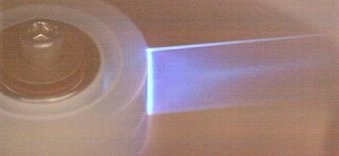
So what has this relationship have to do with x-rays? It turns out that in the process of charge build-up releases some x-rays under the right conditions. But first, if you look at the cover photo of transparent tape being unwound, you see the effect of tribo electricity. The flash of blue light that last only one billionth of a second has been found to emit x-rays as a part of the light emission. The same phenomenon occurs with wintergreen lifesavers, sugar being ground up at high speed, and several other types of tape. I have seen this many times before and wondered about the fact that the light was always blue. If we consider the electromagnetic spectrum we can see that blue light is on the ultraviolet end of the energy level, (10 to the -9 meters) and the next shorter wavelength is in the range of x-rays (10 to the -10 meters).
In 2011, researchers at UCLA were investigating the tribo electric discharge of transparent tape. However, they went a step further and mechanically unwound the tape at a relatively slow speed, 3-5 cm/second, under a vacuum. The vacuum is necessary due to the fact that any gas molecules present absorb the x-ray energy. With a Geiger counter they observed x-rays. Using dental x-ray film, they were able to produce an image of a finger in shadow form. A video on the Nature site is available here.
Since then, they have developed a small device with silicon and a metal filled epoxy to generate the tribo electric x-rays with the hope of making the technology widely available. And additionally, a patent application has been in the works. But, there are still many questions to be answered. I have built x-ray devices using high voltage and vacuum tubes with some reasonable results. I have also investigated triboluminescence and have found it to be short-lived, unpredictable, and difficult to replicate results. For example, humidity can cause the loss of the effect. There is also the size of the area to be covered. Perhaps a very small tumor could be analyzed, but a lumbar x-ray would be impossible. Still, it is interesting science and deserves to be featured on this page.
 RSS Feed
RSS Feed
